| Deep Sky Objects: Nebulae |
| HOME Best Lunar Planets Deepsky Misc Equipment Techniques Links | Galaxies Nebulae Star Clusters Constellations Multiple Stars Messier Objects |
|
Some of the most photogenic objects in the sky beyond the solar system belong to the varied types of nebulae. The word "nebula" comes from the latin for "cloud", and in past centuries was used to refer to all types of deep-sky objects. Nowadays we use the term to refer to those which really are cloud-like, that is agglomerations of gas in deep space.
There are several types of nebula:
Here you can see my images of these different types of nebula. Click on the pictures to expand and see captions |
7 September 2012, NGC 6914 area
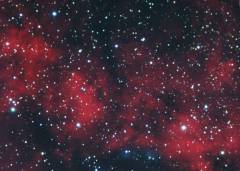
|
The NCG6914 area in Cygnus contains a blue reflection nebula within a large area of red emission nebula. Part of the emission nebula can be seen near the bottom of this image. This image was captured in Hydrogen Alpha plus green, and blue standard filters. I captured two sets of H-Alpha data, the first together with blue and green was binned 2x2. The second was at full unbinned resolution. It was combined using the unbinned H-alpha as luminance the binned images for colour with H-alpha as the red channel. Longer exposures and higher aperture would allow detail within the blue nebula to be captured. Image details:
| |||
| to top | home | |||
8 October 2009, Sh2-101 The Tulip Nebula
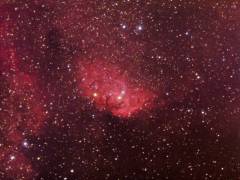
|
The Tulip Nebula is the name given to this emission nebula in Cygnus, Sh2-101 from the Sharpless catalogue of H-alpha regions. As the image below from November 2008 shows, this object is close to a suspected black hole, Cygnus X-1. I added the H-alpha from 2008 to the image I captured this time, to give a better result. This image was captured in Hydrogen Alpha plus red, green, and blue standard filters. It was combined using the H-alpha as luminance and as part of the red channel. Image details:
| |||
| to top | home | |||
26 September 2009, Cederblad 214 Emission Nebula

|
Here is a picture of a Hydrogen alpha area and star cluster in the constellation of Cepheus, located in the Cepheus-Cygnus-Cassiopeia region, where there are many such nebulae. Cederblad 214 is the brighter core of the wider area of NGC7822, although while some sources have the NGC object as the whole area, others have it as just a dimmer part with Cederblad 214 as a separate object. This image was captured in Hydrogen Alpha plus red, green, and blue standard filters. It was combined using the H-alpha as luminance and as part of the red channel. Image details:
| |||
| to top | home | |||
12 September 2009, IC1396 including the "Elephant's Trunk"
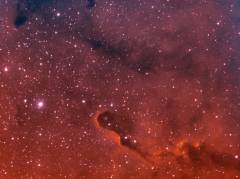
|
This picture is composed of Hydrogen Alpha and Oxygen III filtered images captured over 2 nights in August and September. The two images were combined in a bi-colour technique with H-alpha as red, O III as green, and artificial blue composed of a mixture of the two. This is a close-up of a large emission nebula and star cluster in the constellation of Cepheus. This area has large dust and gas clouds that form the shapes shown here, including the area at the bottom of this image giving it the nickname of the Elephant's Trunk. Image details:
| |||
| to top | home | |||
12 September 2009, Western Veil Nebula
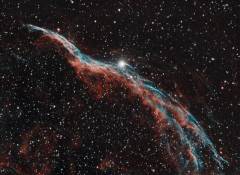
|
This image shows NGC6960, the Western part of the Veil Nebula. Like the Eastern Veil below, it was imaged using H-Alpha and O-III filters and processed using bi-colour technique, assigning Ha to Red, O-III to Green, and synthetic Blue (30% Ha + 70% O-III). To match the other image I blended some of the combination with synthetic Green into the combination with synthetic blue. Of course, like the nebula pictured below, this nebula is part of the larger "Cygnus Loop", or Veil Nebula, a supernova remnant in Cygnus. Image details:
| |||
| to top | home | |||
19 August 2009, Eastern Veil Nebula
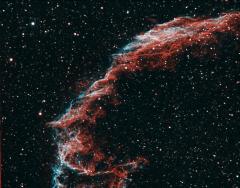
|
This image shows the Eastern part of the Veil Nebula, NGC6992, imaged using H-Alpha and O-III filters. I processed using bi-colour technique, assigning Ha to Red, O-III to Green, and synthetic Blue (30% Ha + 70% O-III). I was not sure about the colours so tried Ha Red, O-III Blue, and synthetic Green in the same ratios. Again I was not sure and ended up blending a little of the latter combination into the former combination, giving the result shown here This nebula is part of the larger "Cygnus Loop", or Veil Nebula, a supernova remnant in Cygnus. Image details:
| |||
| to top | home | |||
17 August 2009, Pickering's Triangle

|
This is known as Pickering's Triangle, it is part of NGC 6979 and is located between the Eastern and Western sections of the Veil supernova remnant in Cygnus. I imaged in H-alpha and O-III and created a bi-colour image. The combining was done as described above in the image of the Eastern Veil. Image details:
| |||
| to top | home | |||
23 January 2009, Orion in Narrowband
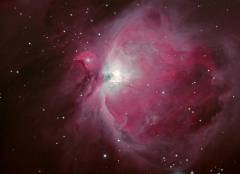
|
This is my first picture using an OIII filter, which allows the capture of light emitted at the characteristic frequency of the Oxygen III emission line. When combined with images captured with the Hydrogen Alpha filter too, that gives two of the necessary colour channels required to produce an RGB colour image. Using the H-alpha as red, and O-III as green, I synthesised a blue channel using 30% H-Alpha combined with the O-III as described in This page. I also mixed in some RGB from a previous M42 image to the star colours. The colours are by necessity false, but are not too far from reality. This kind of "narrowband" imaging shows the structure of the molecular clouds and gases that form the star forming regions and nebulae of this area. Image details:
| |||
| to top | home | |||
6 December 2008, The Horsehead Nebula
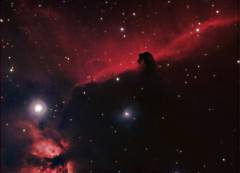
|
Here is another image of the famous Horsehead Nebula in the belt of Orion. This is better than my attempt the previous March, but would still be improved with more exposures. This image also shows the Flame Nebula NGC2024 and a blue reflection nebula to the lower left of the Horsehead in this image, NGC2023. The Horsehead itself is known as B33, after its entry in the Barnard catalogue of dark nebulae. The red emission nebula that surrounds it is IC434. This image was created using the LRGB method, where the Hydrogen-Alpha was used as Luminance, and also blended in to the red channel. Image details:
| |||
| to top | home | |||
6 December 2008, IC59 and IC63 in cassiopeia
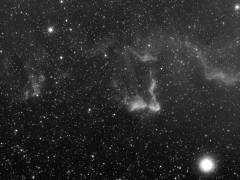
|
IC59 and IC63 are parts of a large area of nebulae in the region of Gamma Cassiopeiae, the bright star in this image. Parts are reflection nebulae, lit by this star, and parts are emission nebulae, shown here as Hydrogen Alpha gas. Click the image for a large (1000 pixel width) picture, or Here for a smaller (800 pixels) version. Image details:
| |||
| to top | home | |||
7 November 2008, The Pacman Nebula NGC281

|
This is a better image than the one I captured a year ago in my first H-alpha image. I used more than twice as much exposure as that image, with the H-alpha filter, and added 45 minutes of colour. They were combined into an LRGB image, using the H-alpha data as luminance. This image shows clearly the hydrogen gas and the dark dusty areas, together with the star cluster at the centre of the nebula. Image details:
| |||
| to top | home | |||
7 November 2008, The Tulip Nebula - and a black hole?

|
The Sharpless catalogue is a list of hydrogen alpha regions, otherwise known as emission nebulae. Sh2-101 is one of these regions, known as the Tulip nebula. It is located in Cygnus, where there is an awful lot of hydrogen gas floating around, and the bright nebulae are just higher concentrations or brighter areas in the gas. This image also has something special - although it's not obvious from looking. Cygnus X-1 is a bright X-ray source, and is thought to be a binary system where a black hole is orbiting with a supergiant star. Naturally the black hole is not visible but the star is marked on the image. Image details:
| |||
| to top | home | |||
12 March 2008, Barnard 33 - The Horsehead Nebula, and the Flame nebula NGC2024
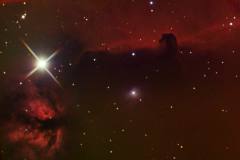
|
It took me several attempts to capture some reasonable colour frames for B33 (the Horsehead nebula) this year, as I had left it a little late in the season. This image is based on the Hydrogen Alpha image from 26 February 2008 (below), which was used as luminance.
Also in the image of course is the famous Flame Nebula, or NGC2024.
Image details:
| |||
| to top | home | |||
24 February 2008, IC410 and NGC1893 - Nebula and Open Cluster
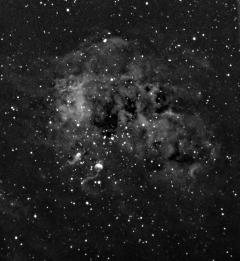
|
IC410 is an emission nebula in the constellation of Auriga, near to IC405 (see below). This nebula is notable for the tadpole-like formations in the gas. This image was captured over a couple of nights, I merged together the data from both sessions to produce this result. Image details:
| |||
| to top | home | |||
24 February 2008, NGC2264 - the Flame Nebula and Christmas Tree Cluster
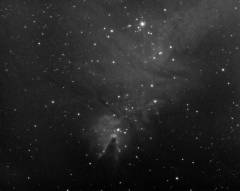
|
This picture is of an emission nebula 2400 light years away in the constellation of Monoceros. The small cone-shape that gives the nebula its name can be seen at the bottom of the image. There is a lot more gas than just that small cone though, and there is a cluster called the Christmas Tree cluster in the same location.
This image could do with some more exposure - I captured 54 minutes but stacked only 40 minutes because of poor quality of the last ones as the object sank into the low sky. It was a bit tricky to process because of this. Image details:
| |||
| to top | home | |||
26 February 2008, Barnard 33 - The Horsehead Nebula, and the Flame nebula NGC2024
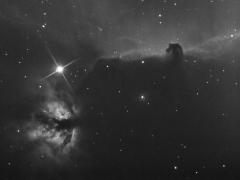
|
This image shows the famous Horsehead nebula in Orion, also known as the dark nebula B33, and nearby NGC2024 or Flame Nebula.
Image details:
| |||
| to top | home | |||
16 February 2008, NGC1499 - The California Nebula

|
Here is an image of part of the California Nebula, a large emission nebula in the constellation of Perseus. It is located fairly close to us at about 1500 light years away.
This image was captured using a Hydrogen Alpha filter. Since the nebula is so large, I used a focal reducer to get an increased field of view, although only part of the nebula fits in nevertheless. To see the nebula in context, see my other images showing this object: ngc1499_20070203.jpg and Comet Macholz in Perseus. Image details:
| |||
| to top | home | |||
31 January 2008, M42 and M43 - The Orion Nebula
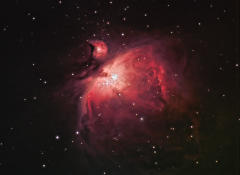
|
This is my first image of the Orion nebulae for over 2 years. It's also the first using this camera, and the first using a hydrogen-alpha filter.
I added the hydrogen-alpha data in with the red, and also blended it with the luminance to produce a colour image with boosted red from the H-alpha. Image details:
| |||
| to top | home | |||
10 December 2007, IC405 - The Flaming Star Nebula
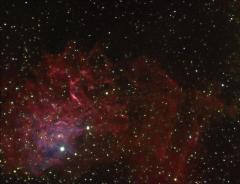
|
IC 405 is an emission nebula in Auriga, the constellation of the Charioteer. It is sometimes known as the Flaming Star Nebula, because of the appearance of the bright part near the star AE Aurigae, which lights up the nebula. This is primarily an emission nebula, composed of the red hydrogen gas, but the bright area around AE Aurigae looks purple because of an area of reflection nebula (normally blue) mixed in.
This was my first attempt at mixing hydrogen-alpha data in with RGB to produce a colour image with boosted red from the H-alpha. Image details:
| |||
| to top | home | |||
7 December 2007, NGC281 - The Pacman Nebula
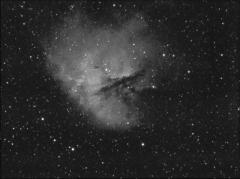
|
This is my first image using in Hydrogen-Alpha light. I used a Baader 7nm H-alpha filter to image this emission nebula in the constellation of Cassiopeia. Its shape gives it the nickname of the Pacman Nebula.
Image details:
| |||
| to top | home | |||
7 September 2007, NGC6992 - The Western Veil Nebula
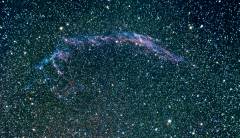
|
Following my image of the Eastern part of the Veil Nebula in Cygnus (see below), I turned my attention to the Western half of the same object. This part of the Veil is slightly brighter than the Eastern part but not quite so easy to find as it doesn't have a bright "marker star".
Image details:
| |||
| to top | home | |||
5 September 2007, NGC6960 - The Eastern Veil Nebula
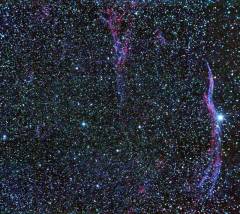
|
The Veil Nebula complex is located in Cygnus and is a series of wispy areas of gas left over from a supernova many years ago. This image shows the Eastern part of the nebula, located close to the magnitude-4 star 52-Cygnii. Also in the image is another part of the Veil commonly called Pickering's Triangle. It can be seen in the top-centre of this picture.
Image details:
| |||
| to top | home | |||
3 February 2007, The "Heart and Soul" Nebulae
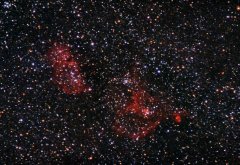
|
Like the picture below, this is another film image. This time I took 13 pictures of this pair of emission nebulae, which are near to the famous Perseus double cluster, but over the border in the constellation of Cassiopeia. The "heart" nebula, on the right in the picture, has the designation IC1805, while the "soul", also known as the "baby" nebula for its shape, is officially known as IC1848.
The exposures varied between 5 and 10 minutes each. I had the film processed (pushed one stop) and scanned for me to JPG format. Then I used Deep Sky Stacker to stack 13 images and post-processed using PixInsight LE. | |||
| to top | home | |||
3 February 2007, NGC1499 - the California Nebula

|
For this image I returned to taking some photographs on film. I used my old 35mm SLR camera with a 135mm lens and shot 8 pictures of the California Nebula, an emission nebula in the constellation of Perseus. The lens was set to f/3.5 and the exposures varied between 5 and 10 minutes each.
I had the film processed (pushed one stop) and scanned for me to JPG format. Then I used Deep Sky Stacker to stack the 8 images and post-processed using PixInsight LE. | |||
| to top | home | |||
12 December 2006, Orion's sword

|
This image of M42 and the rest of Orion's sword, was captured using my EOS300D camera on the Megrez 80 II SD. I used a Baader contrast booster filter, which appears to have helped a lot with preventing blue fringing on the stars, and on preventing skyglow. Because of the variation in brightness I captured a range of images - this is a stack of images ranging from 20 to 120 seconds.
The camera was controlled using my home-made control cable. I used Deep Sky Stacker to align and stack, and postprocessed in PixInsight LE and The Gimp. | |||
| to top | home | |||
20 July 2006, M16 - the Eagle Nebula

|
Messier 16 is known as the Eagle Nebula and consists of an open cluster embedded in a large patch of nebulosity. The centre of the nebula contains the features made famous by the Hubble Space Telescope and consequently known as the Pillars of Creation. M16 is in the constellation of Serpens Cauda in the Milky Way and can be found low down in the South from my location during the summer months. This black and white photo was captured using my Vesta SC3 modified webcam attached to my Megrez 80 II SD. I used a Baader IR-blocker and a contrast booster, which helped somewhat with the milky sky at that altitude. I used K3CCDTools to stack 82 frames. The image was post-processed using PixInsight LE, Iris, and The Gimp. The camera was in B&W RAW mode, and the settings were:
| |||
| to top | home | |||
27 June 2006, M57 - the Ring Nebula
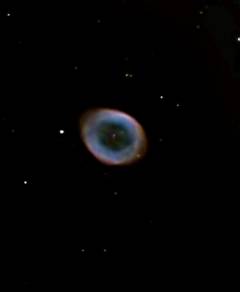
|
M57 is a classic example of a planetary nebula, formed by a star throwing off layers of gas at the end of its life. The ring nebula is a relatively bright nebula. I captured a black-and-white image using my SC3 Vesta webcam and merged it with the colour image from 6 August 2004 (see below).
The image was post-processed using PixInsight LE and The Gimp. The camera was in B&W RAW mode, and the settings were:
| |||
| to top | home | |||
17 February 2006, M1 the Crab Nebula
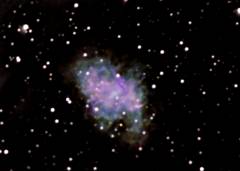
|
This is an image of the first object in Messier's catalogue, the Crab Nebula. This is the remnant of a supernova and is actually a cloud of filaments of gas with a spinning star at its centre -- a pulsar. I first imaged this object in December 2004, with my colour SC1 camera, and I have returned to it using the more sensitive, black and white SC3 webcam. I captured 84 20-second frames at prime focus of my Orion 250 f/5 Newtonian telescope, and stacked 67 of them using K3CCDTools. I captured 15 dark frames with the camera covered, which were summed and subtracted from the original image frames. The image was post-processed using PixInsight LE and The Gimp. | |||
|
The picture above is in colour because I used the colour image from December 2004 (see below) and used it to provide colour information for the black and white image I got with the SC3 camera. To see the original SC1 colour picture click HERE. Below is the black and white image alone. In fact this image could be a lot better because my telescope was not in good collimation (optical alignment) when I took this image. |
||||

|
The camera was in B&W RAW mode, and the settings were:
| |||
| to top | home | |||
25 January 2006: The Rosette Nebula and Open Cluster
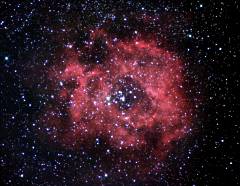
|
In the constellation of Monoceros (The Unicorn), lies this cluster and nebula. The cluster at the centre is designated NGC2244. It contains young stars forming from the gas in the nebula, which has been given catalogue numbers NGC2237, 2238, 2239, and 2246 to describe its various parts. The nebula is large, covering over one degree of arc across the sky. A young star was discovered there as recently as 2004, as described in This press release.
This image is a stack of 8x5-minute exposures. They were captured with my EOS 300D camera at prime focus of my Megrez 80 II SD telescope, with the camera set to ISO 800 and an Astronomik CLS filter was used. The frames were stacked in K3CCDTools, then post-processed using PixInsight LE and The Gimp. | |||
| to top | home | |||
23 December 2005: Horsehead and Flame Nebulae in Orion's Belt
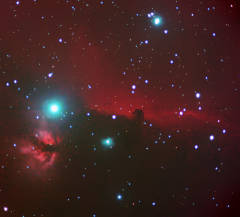
|
The constellation of Orion holds many other interesting objects in addition to the so-called Orion Nebula. One of the most well-known objects in the sky is the Horsehead Nebula, or Barnard-33. This is a dark nebula which shows up against a red background of glowing hydrogen gas. Of course it gets its name from its distinctive shape.
B-33 is located to the south of the leftmost star in the group of three known as Orion's Belt. This star is called Alnitak and is the brightest in this picture. Nearby is another nebula known by the catalogue number of NGC2024, or more frequently, by its familiar name of the Flame Nebula. This is another mixture of red glowing gas and dark lanes, and is thought by some to resemble a tree in appearance. This image is a stack of 13x5-minute exposures. They were captured with my EOS 300D camera at prime focus of my Megrez 80 II SD telescope, with the camera set to ISO 800 and an Astronomik CLS filter was used. The frames were stacked in K3CCDTools, then post-processed using PixInsight LE and The Gimp. These deep-sky-objects are fainter than the other orion nebulae pictured below, and require much more exposure time on the camera. I will capture more images of these items when possible, and combine them with the image shown here to improve the detail and reduce noise. | |||
| to top | home | |||
6 December 2005: Orion's Sword: M42, M43, NGC1977

|
This year I have better equipment with which to image the great Orion Nebula. This image was captured at prime focus of my Megrez 80 II SD refractor with the Canon EOS300D camera. It shows the great emission nebula M42 with the smaller comma-shaped companion M43. Also in the picture is the blue reflection nebula NGC1977, or the Running Man. Lastly, the bottom-left of this picture shows the cluster of stars that form the lower end of Orion's famous sword.
As is common with pictures of this nebula, this image is formed from a composite of long and short exposures. On this occasion I used is 4x20sec, 5x30sec, 1x1min and 1x2min all captured at ISO 800. The result shows detail in the core as well as some of the fainter outlying nebulosity. I stacked the individual same-length exposures using K3CCDTools, then combined them and post-processed in PixInsight LE. Final tweaks were done using The Gimp. This region holds much more nebulosity and glowing gas than is shown here. I will be trying to get more exposures of Orion and adding to this image in the future. | |||
| to top | home | |||
24 November 2005: IC1396 Emission nebula in Cepheus
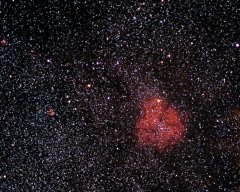
|
Like the California Nebula picture below, this is a picture taken on Kodak Elite Chrome 200 35mm film. This is a stack of 2x15 minutes with a 135mm lens at f/3.5. The film processing was pushed 2 stops then scanned and processed in PixInsight LE and The Gimp. As can be seen, there is a large number of stars in this part of the sky as the Milky Way passes by. There are a few little bits of nebulosity around apart from IC1396, which is the name of both the red nebula and the star cluster embedded within. As are many red nebulae, this is a star-forming region containing a cluster of young stars. | |||
| to top | home | |||
24 November 2005: NGC1499, the California Nebula
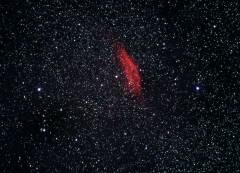
|
This is NGC1499, known as the California nebula. It is an emission nebula in the constellation of Perseus . For this picture I exposed for 15 minutes on Kodak Elite Chrome 200 film, with 135mm lens @ f/3.5. The processing was pushed 2 stops. The picture was scanned and processed further in PixInsight LE, and The Gimp. | |||
| to top | home | |||
6 November 2005: IC1318, Nebula near Gamma Cygni

|
After recent success with the North America and Pelican Nebulae, I continued the Cygnus theme and moved to Gamma Cygni (Sadr) and the so-called Butterfly Nebula (IC1318). The picture is a stack of 12x5-minutes unguided with my EOS300D at prime focus of the ST80 80mm f/5 refractor.
Unfortunately this picture shows a little distortion in the stars, caused partly by less-than-perfect polar alignment of the telescope mount, and partly by coma from the non-flat field of the telescope (perfect focus can not be achieved across the whole size of the camera's sensor). The dark area between the two halves of the "butterfly" is LDN889, and the small cluster just above and to the left of Gamma is NGC6910. The images were stacked using K3CCDTools and processed using PixInsight LE and The Gimp. | |||
| to top | home | |||
4 November 2005: NGC7000, the North America Nebula and IC5070, the Pelican Nebula

|
This picture shows a region full of glowing gas and nebulae on a backdrop of dense Milky Way star fields in the constellation of Cygnus. The two named objects are emmision nebulae. NGC7000 is a large bright nebula containing several clusters of stars. IC5070 is another, similar, nebula which although not quite so bright, is close enough to NGC7000 to be well-known, not least for its characteristic shape, for which it was named the Pelican Nebula. There are many other named and unnamed glowing areas of gas in this area, some of which are shown in this picture.
For this image, which was captured using the Canon EOS300D DSLR attached to my ST80 refractor, I used my Astronomic CLS filter for the first time. This had the effect of suppressing the background glow and allowing the light emitted by the nebulae and stars to pass. I captured 12x5-minute exposures at ISO 1600. The images were stacked using K3CCDTools and processed using PixInsight LE and The Gimp. | |||
| to top | home | |||
1 September 2005: M8 and M20 area

|
I took this picture on my trip to Spain in Summer 2005. From my location there I had a much better view of the southern sky and in particular, the constellation of Sagittarius, with the centre of the Milky Way and many deep-sky objects.
This image is a stack of 9x30-second frames and 1 60-second frame, captured with my Canon EOS300D DSLR camera fitted with a 300mm lens. It shows many DSOs including the Lagoon Nebula, M8 in the centre, and M20, the Trifid Nebula to the upper right. These two are emission nebulae, large glowing regions of Hydrogen gas. M8 is a star-forming region wherein a cluster of newly-formed stars can be seen (the cluster has the designation NGC6530). M20 is known as the Trifid nebula, for its tripartite appearance, and is also a red emission nebula with a cluster of young stars although the latter is less conspicuous as M8's cluster. There is a blue reflection nebula in the northern part, caused by the light from these stars. Above M20 is M21, an open cluster believed to contain 57 stars. Finally to the lower left of the picture are two faint globular clusters, NGC6544 and NGC 6553. Processing was done in PixInsight LE. | |||
| to top | home | |||
6 August 2004/7 September 2005: Composite M27

|
For this picture I took the colour image of the Planetary nebula M27 from 6 August 2004 (captured with the QC3000 webcam) and the black and white image below from 7 September 2005, and combined them. The black and white image was captured using my SC3 modified webcam which is much more sensitive, and so the image contains a lot more detail than the colour one. I reprocessed the original colour frames, using PixInsight LE, then used the black and white one as a luminance (brightness) layer. | |||
| to top | home | |||
7 September 2005: Another M27
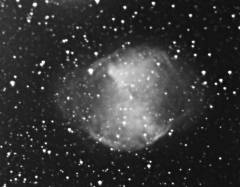
|
I was interested in capturing another picture of M27, because of the variable star that recently flared up (VarVul05). This was a quick capture of 40x15 seconds, captured using my Vesta SC3 webcam in B&W mode.
The frames were stacked in K3CCDTools, and post-processed using PixInsight LE. For information on VarVul05, see here:http://www.aavso.org/publications/alerts/alert325.shtml. Pictures available here: http://sabbe.fragzone.se/KPO/05081827.htm, here: http://spiff.rit.edu/richmond/ritobs/sep05_2005/sep05_2005.html, or here: http://www.tboeckel.de/EFSF/efsf_ps/deepsky/M27_hantel/hantel_var_e.htm. | |||
| to top | home | |||
23 August 2005: SC3 Camera First light: M27
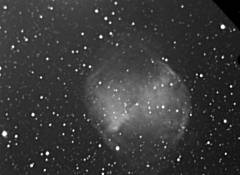
|
This picture was the first I captured using my new Philips Vesta webcam modified to the SC3 standard - long exposures and a replacement image sensor chip.
The new image sensor is more sensitive partly because it is black and white rather than colour. For this "First Light" image I didn't use any colour filters so the picture is in black and white. I chose M27 because it's an easy object to find in the sky and reasonably bright. Also there was an interesting newly-discovered variable star active at the time this image was taken. 222 frames were captured in B&W RAW mode, and 139 were stacked in K3CCDTools to create this image. I did post-processing including contrast adjustment, sharpening, and noise reduction using PixInsight LE. That software has a very effective "A Trous" wavelet transformation function that is useful for removing the fine diagonal-line noise that was apparent on the picture. | |||
| to top | home | |||
12 February 2005: Orion's Sword
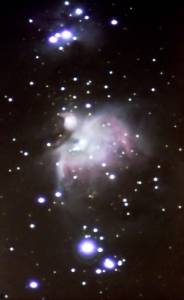
|
With the unaided eye, Orion's sword looks like three stars. A little optical aid reveals that the central one is really a fantastic nebula with a bright core and subtle outer regions. This large nebula is Messier object 42, while the comma-shaped upper part is M43. At the top of the picture is another nebula, NGC 1977, known as the Running Man nebula, because the dark areas are reminiscent of the silhouette of just that. The blue areas are a reflection nebula, glowing by reflected light from the stars in that area. This image is a composite (not a mosaic) of many different exposures, captured using the QC3000 with a 135mm SLR lens, stacked and merged. The main picture is a stack of 72 20-second frames, with overlays of 10-second, 5-second, and 2-second exposures merged into the core of M42 for the details that get overexposed with longer exposures. Also some 30-second exposures were stacked into the Running Man nebula region to better show that part. Due to the high winds on the night I captured this, many frames were discarded, leaving just the best. The stacking was done with Registax3 and K3CCDTools, the image colours were processed with The Gimp (levels adjusted on each stack of similar exposures, then curves adjusted on each stack). Then the colour balance was adjusted to match as each shorter exposure part was merged in, also in the Gimp. Finally noise was reduced slightly using NeatImage. |
|||
| to top | home | |||
18 December 2004: M1, The Crab Nebula
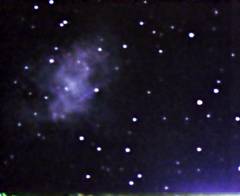
|
The first object in Messier's list, M1 (also known as the Crab Nebula), is the remnant of a star that exploded in a supernova almost 1000 years ago.
This picture was captured at prime focus of my Europa 250 telescope, using the QC3000 camera. I stacked 35 frames of 25 seconds each, using Registax 2. The picture was processed in the Gimp as usual, and further reprocessed nearly a year later using PixInsight LE. |
|||
| to top | home | |||
14 November 2004: M42, the Great Orion Nebula
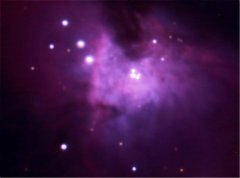
|
M42, or the Orion Nebula, is one of the most popular
deep sky objects with observers. It is a large
object and very bright. It is formed of large
expanses of glowing gas and contains star-forming
regions where new stars are being born. In the
centre is a small group of four stars known as the
Trapezium.
This picture was captured at prime focus using the QC3000 and due to the nebula being much larger than the field of view of the camera, only shows the central region of the nebula. To create the final picture, 50x1sec, 50x5sec, 1x10sec, 5x30sec and 2x51sec exposures were stacked individually in K3CCDTools then merged and processed in the Gimp. |
|||
| to top | home | |||
6 August 2004: The Ring Nebula
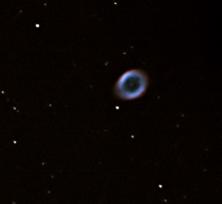
|
This is M57, the Ring Nebula in the constellation of Lyra. It shows to an extent, why planetary nebulae are so-called. This is a small nebula but fairly bright, and through a low-powered eyepiece resembles an out-of-focus star. This image was formed from stacking around 40 exposures of 25 seconds each, then processing in iPrep, K3CCDTools, the Gimp, and NeatImage. This image was taken using the long-exposure modified QuickCam 3000. CLick the picture to enlarge it. | |||
| to top | home | |||
6 August 2004: The Dumbbell Nebula

|
When old stars die, some of them will throw off a shell of gas and turn into a so-called "planetary nebula". One nice example is M27, the Dumbbell Nebula, in the constellation of Vulpecula. This image was formed from stacking around 40 exposures of 20 seconds each, then processing in iPrep, K3CCDTools, the Gimp, and NeatImage. This image formed the "first light" with my long-exposure modified QuickCam 3000, and as such was my first true "deep sky" picture. CLick the picture to enlarge it. | |||
| to top | home | |||
 |
||||
| All images copyright and may not be used without permission |
||||